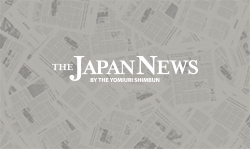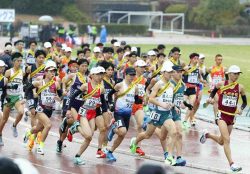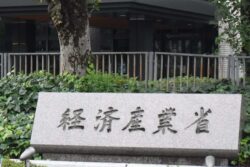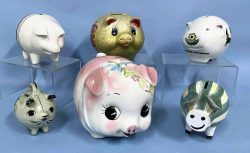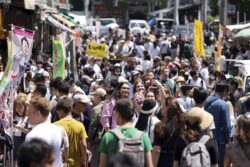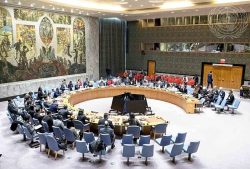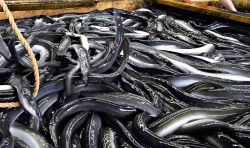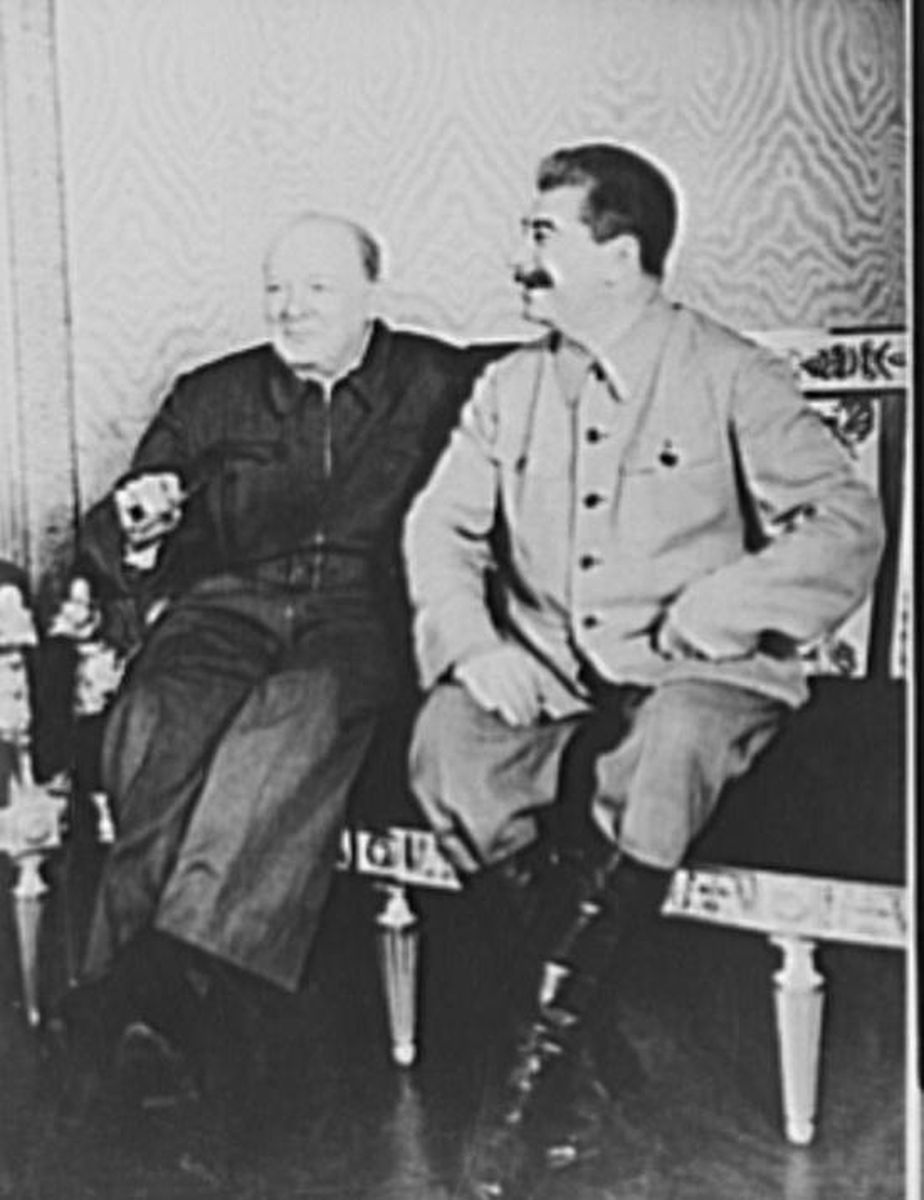
Churchill wore his siren suit when he met with Joseph Stalin at the Kremlin in August 1942.
12:14 JST, March 4, 2025
“Why did he wear a flying suit to the state dinner in the Kremlin?” was the question banging around Moscow when Prime Minister Winston Churchill shocked a room full of more sedately clad political leaders during a 1942 visit.
By that time, though, Churchill’s powder-blue zippered suit – a wartime onesie – was a hit in the West.
“That strange costume Mr. Churchill wore was recognized in Britain, Canada and the United States as a ‘siren suit’, a zipper coverall to be donned quickly in the event of air raid alarms,” Eddy Gilmore wrote for the Associated Press on Aug. 18, 1942.
Churchill had worn the same suit months earlier on a visit to Washington a few weeks after the United States entered World War II.
On that visit, during the first week of 1942, he took a break from meetings with President Franklin D. Roosevelt to sneak away to the White House Spanish Garden to feed a family of squirrels, a United Press story said. But a couple dozen Washington news photographers pounced when they saw his suit.
“I call it my siren suit,” Churchill explained, gripping a cigar in his teeth to unzip the top of the suit, revealing a vest but no coat underneath. The media reports described him as chipper, lifting his legs and showing off his zippered shoes. “I can get into it in half a minute.”
Two days later, first lady Eleanor Roosevelt said she wouldn’t mind getting one made for the president, if “the wool shortage” would allow it.
Today’s Washington wasn’t as kind when Ukrainian President Volodymyr Zelensky arrived at the White House last week in the combat gear he insists on wearing while his nation is at war.
“Why don’t you wear a suit? You’re in the highest level of this country’s office, and you refuse to wear a suit? I just want to see, do you own a suit?” Brian Glenn, a commentator for the Real America’s Voice outlet, asked Zelensky.
“A lot of Americans have problems with you respecting this office,” Glenn added.
Zelensky, surrounded by men in suits, responded quickly.
“I will wear costume after this war will finish,” Zelensky said. “Maybe something like yours, yes, maybe something better, I don’t know.”
During World War II, Churchill’s “famous siren suit” was mentioned frequently, with the media noting each time he made the sartorial statement about his nation’s state of war.
“Mr. Churchill started wearing the air raid (siren) suit during the blitz and finds it suits his purpose well,” a British official explained to the Canadian Press on Churchill’s visit to Quebec on Aug. 25, 1943. “He says it’s much easier to step into one of those suits and pull a zipper to get dressed than to go to all the bother of putting on a shirt, collar and tie.”
Churchill was inspired by coal miners’ coveralls when he asked one of London’s bespoke tailors to create one for him.
“The design really came into its own during the Blitz, when Churchill instructed Turnbull & Asser to supply multiple versions of what his children called his ‘romper suit’,” according to the Turnbull & Asser archive. “He was very specific about his requirements: the garment had to be generously cut, with two breast pockets, a zip fastening, roomy side pockets, a belt and pleats to the front of the trousers.”
The iconic menswear house made them in variations including pinstripes, a durable serge twill and green velvet. They still have that luxe one in their London headquarters.
The suit’s symbolism was acknowledged and not scorned by American leaders.
“Churchill, wearing his famous siren suit, got out of his plane about noon. The President greeted him warmly and drove him to the house in his own personal car,” Roosevelt’s wartime secretary, William D. Hassett, noted in his diary on June 19, 1942.
After a long conference after lunch and tea with the president’s eccentric cousin, Laura Delano, the leaders had dinner at the president’s home, Hassett said in his memoir, “Off the Record with FDR.”
“The President put on a black tie and white dinner coat,” Hassett wrote. “Winnie came down in the siren suit, for which he apologized. O.K. with the Boss.”
Though Churchill made it famous, the “siren suit” had debuted as an avant-garde whim in the fashion world a year earlier.
“This air raid shelter outfit, showed the recent Empire Fur Show in London, is called a siren suit. ‘Siren’ refers to an air raid warning, not the suit’s wearer,” read the caption on a photo in the Feb. 14, 1941, Visalia Times-Delta featuring a stylish, hooded romper made of Australian wallaby fur.
It was part of a bold statement about a war that felt far away during a New York fashion show in the Rockefeller Center’s Rainbow Room on Oct. 21, 1941, a little more than a month before the United States entered World War II.
Models strutted in a “siren suit” made of navy blue gabardine for air raids, a companion suit for children had bunny ears “to make the donning of the suit more of a game,” New York media reported.
The line included “warm dinner gowns for fuelless evenings” and bicycle suits for folks to stay fashionable while pedaling during gasoline shortages.
Churchill wore the siren suits after the war, but mostly when he was painting or relaxing.
Others saw the potential in its simplicity and comfort.
“Even after the war, a siren suit like that with which Churchill astonished Moscow may still have a wide field of usefulness,” the Boston Herald wrote in January 1943. “It works on zippers and has no buttons and might be just the thing for homekeeping husbands whose wives take long summer vacations.”
"News Services" POPULAR ARTICLE
-

American Playwright Jeremy O. Harris Arrested in Japan on Alleged Drug Smuggling
-

Japan’s Nikkei Stock Average as JGB Yields, Yen Rise on Rate-Hike Bets
-

Japan’s Nikkei Stock Average Licks Wounds after Selloff Sparked by BOJ Hike Bets (UPDATE 1)
-

Japan’s Nikkei Stock Average Buoyed by Stable Yen; SoftBank’s Slide Caps Gains (UPDATE 1)
-

Japanese Bond Yields Zoom, Stocks Slide as Rate Hike Looms
JN ACCESS RANKING
-

Keidanren Chairman Yoshinobu Tsutsui Visits Kashiwazaki-Kariwa Nuclear Power Plant; Inspects New Emergency Safety System
-
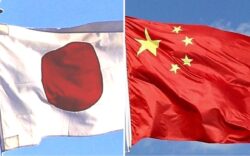
Imports of Rare Earths from China Facing Delays, May Be Caused by Deterioration of Japan-China Relations
-

Tokyo Economic Security Forum to Hold Inaugural Meeting Amid Tense Global Environment
-

University of Tokyo Professor Discusses Japanese Economic Security in Interview Ahead of Forum
-
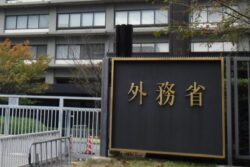
Japan Pulls out of Vietnam Nuclear Project, Complicating Hanoi’s Power Plans


